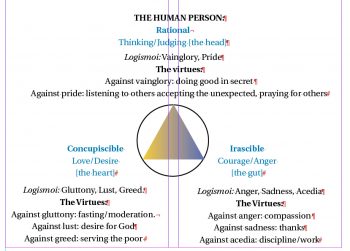School for Prayer (13) Evagrius of Pontus (5) – The human person in Christ
By Fr Craig Larkin sm, 1943 - 2015
Putting it Together
According to Evagrius’ teaching, the human person, with its strengths and struggles, can be illustrated like this:

How the Logismoi operate
The Fathers, following Evagrius, outline a number of ‘stages’ in the struggle with the logismoi.
1. Provocation – the logismos simply appears.
2. Connection – the person accepts the logismos and begins a dialogue with it.
3. Wrestling – some struggle takes place.
4. Consent – the person gives in to the logismos.
5. Actualization – the person puts it into practice.
6. Captivity – in time (soon) this act becomes a habit.
In the first stage there is no sinfulness at all.
In the second stage we are on dangerous ground.
In the third stage the game is almost lost.
In the fourth stage there is sinfulness.
In the fifth stage the game is over.
In the sixth stage, you need help!
What to do in the struggle
Evagrius offers four Rules for dealing with the logismoi:
1. At first, just observe the logismoi, noting how and when, and under what circumstances they come to you.
2. Don’t dialogue with them! Don’t take the ‘connection’ stage any further.
3. Answer back with Scripture, following the example of Jesus in his temptation in the desert.
4. Reveal your thoughts to your spiritual director.
What happened to Evagrius and his teaching?
Evagrius was a disciple of Origen (184-253). When Origen’s teachings were condemned, so was Evagrius condemned.But his teaching continued to be spread, though under other names (St Nilus of Sinai, for example). John Cassian brought Evagrius’ teachings to the West.
But in doing so, he changed the meaning of logismoi from ‘ideas/thoughts’ to something more like ‘sinful actions’.
St Gregory the Great took this teaching, changed the list, and renamed it the ‘Seven Deadly Sins’.
Something of the psychological/spiritual insight of Evagrius has been lost – at least in the West.
In recent years the West has re-discovered Evagrius and his teachings.
He reminds us that:
1. Prayer is not a time for introspection or self-pity; rather it is a fruit of joy and of thanksgiving.
2. We cannot go into prayer without taking account of what’s happening with our body, and what’s happening in our mind.
3. What a person does with food, drink, sex and possessions has an impact on what happens to that person in time of prayer.
4. What goes into a person through the eyes, the ears or the stomach is going to have its effect when the person tries to be still at the time of prayer.

“The Cell is like the furnace of Babylon; it is also like the pillar of Cloud where God spoke with Moses.”
An Elder of the Desert
5. Those seeking a life of prayer must begin by cultivating a certain wholeness, an inner calm, an emotional equilibrium.
6. This inner calm is upset by ‘thoughts’ that beset us: emotional traps, soft spots where we are most vulnerable, ‘cracks in the heart’. These are the Logismoi.
7. It’s important to know where the logismoi find their way into our hearts, and to resist them at the beginning.
8. Praying with anger in the soul is like drawing water from a well and putting it in a leaky bucket.
9. It’s crucial to build up and practice the good habits.
10. It’s wise to reveal your thoughts to your director.
 Entries(RSS)
Entries(RSS)